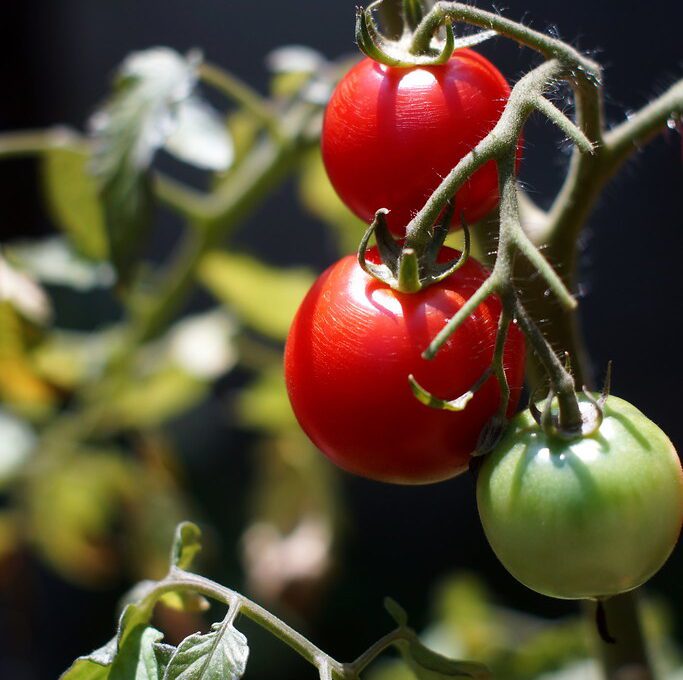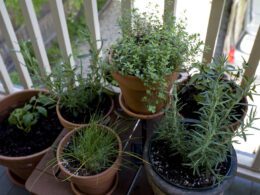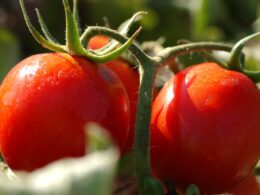You’re excited about your tomato plants and eager to provide them with the nutrients they need, so you generously apply fertilizer. But did you know that too much of a good thing can actually harm your precious plants?
Over-fertilizing tomato plants is a common mistake made by both novice and experienced gardeners alike, leading to issues that not only jeopardize the health of the plant but also compromise its fruit production. Ensuring the safety and well-being of your garden starts with understanding how to strike the right balance in fertilization.
In this article, we’ll discuss what over-fertilized tomato plants look like, including warning signs to watch out for and potential causes for such an issue. We’ll also explore ways to correct over-fertilization problems and offer tips on how to properly nourish your tomatoes while keeping them safe from harm.
By maintaining an optimal level of nutrients, you’ll be able to enjoy a bountiful harvest without any worry or regret. So let’s dive in and learn more about safeguarding your garden from excessive fertilizers!
The Dangers of Over-Fertilizing Tomato Plants
It’s crucial to be aware of the risks associated with over-fertilizing your precious tomato plants, as it can lead to some unsightly and damaging consequences.
Applying too much fertilizer can cause a buildup of salts in the soil, which creates a toxic environment for your plants. This excess salt content prevents them from absorbing essential nutrients and water, ultimately causing stunted growth, yellowing leaves, and even fruit loss.
When you over-fertilize your tomato plants, they become more susceptible to diseases and pests. The excessive nutrients create lush foliage that attracts insects like aphids and spider mites. Additionally, an abundance of nitrogen may promote the growth of fungal infections such as early blight and powdery mildew.
To keep your garden safe and thriving, it’s important to maintain a balanced fertilization routine tailored to the specific needs of your tomato plants.
To prevent these issues from arising in your garden, make sure you properly test your soil before applying any fertilizer. By understanding the nutrient composition of your soil, you’ll be able to provide just enough nourishment for healthy plant development without going overboard.
Monitoring plant health throughout their growth cycle will also help you identify any imbalances early on so that you can adjust accordingly – keeping both you and your tomatoes safe from harm!
Signs of Over-Fertilized Tomato Plants
Have you noticed yellowing or wilting leaves on your tomato plants? This could be a sign of over-fertilization. Over-fertilization can also result in excessive foliage growth with little fruit production and stunted growth with weak stems. Keep an eye out for these indicators to ensure your tomato plants are healthy and thriving.
Yellowing or wilting leaves
When you’ve over-fertilized, you’ll likely notice yellowing or wilting leaves on your tomato plants. This is a clear sign that something is off balance in the soil, and your plants are struggling to cope with the excessive nutrients.
The yellowing often begins at the lower leaves and works its way up the plant, eventually causing them to wilt and fall off. It’s crucial to address this issue promptly because overly fertile soil can lead to poor fruit production and even kill your beloved tomato plants.
To restore balance and ensure the safety of your tomato plants, start by ceasing any further fertilizer applications immediately. Then, flush out excess nutrients from the soil by watering it thoroughly for a few days in a row – just be careful not to drown your plants.
Keep an eye on new growth as it could indicate that your efforts have been successful in reversing the damage caused by over-fertilization. Remember that moderation is key when feeding your tomato plants; they’ll thrive if given just enough nutrients rather than too much, which may harm them instead of helping them grow strong and healthy.
Excessive foliage growth with little fruit production
You might be heartbroken to see your precious garden overrun with lush foliage but only a few tomatoes, and that’s often a telltale sign you’ve over-fertilized. When there is an excess of nutrients, especially nitrogen, tomato plants will focus more on growing leaves and stems rather than producing flowers and fruits.
This rapid growth might seem impressive at first glance, but it comes at the expense of those juicy tomatoes you were looking forward to. To avoid disappointment and ensure a bountiful harvest, make sure to follow recommended guidelines for fertilizing your tomato plants.
These recommendations vary based on factors such as soil type and the specific variety of tomato you’re growing. By doing so, you’ll create a balanced environment where your plants can thrive safely without sacrificing fruit production. Remember that moderation is key – too much fertilizer can do more harm than good in your garden oasis.
Stunted growth and weak stems
On the flip side, stunted growth and weak stems in your garden might indicate that you’re not providing enough nutrients for your tomato plants to flourish. It’s essential to strike a balance when fertilizing, as insufficient nutrients can be just as harmful as too much.
Your tomato plants need a proper supply of essential elements like nitrogen, phosphorus, and potassium to grow strong and healthy. Weak stems may cause your plants to topple over or become susceptible to pests and diseases.
To keep your tomato plants safe and thriving, monitor their appearance closely and adjust their fertilizer intake accordingly. You can start by using a slow-release fertilizer or an organic option like compost or well-rotted manure. Be sure also to follow the recommended application rates on the product label.
If you notice any signs of stunted growth or weak stems, increase the nutrients gradually until you find the perfect balance for optimal plant health. Remember that a flourishing garden is not only visually appealing but also provides a sense of security knowing you’re growing healthy produce for yourself and your loved ones.
Causes of Over-Fertilization
When discussing over-fertilization, it’s important to consider two key factors: incorrect application rates and using the wrong type of fertilizer.
You may unintentionally be causing harm to your plants by not following the recommended guidelines or choosing an unsuitable product.
Let’s dive into these causes and learn how you can avoid them in the future.
Incorrect application rates
Overdoing it on the fertilizer front can lead to a sorry sight, with wilted leaves, stunted growth, and an overall unhappy appearance. Incorrect application rates are one of the main causes of over-fertilization in tomato plants.
You might think that adding more fertilizer will give your plants an extra boost, but in reality, you’re just setting them up for problems. Too much of a good thing can be harmful – and this applies to fertilizers as well.
To avoid these issues and keep your tomato plants healthy and thriving, always follow the recommended application rates provided on the fertilizer package or by a trusted gardening expert. Don’t let your subconscious desire for safety trick you into thinking that excess is better; when it comes to fertilizing your tomato plants, less is often more!
Stick to the guidelines and enjoy watching your garden flourish without risking any nutrient overload disasters.
Using the wrong type of fertilizer
You might be wondering how using the wrong type of fertilizer can impact your garden, and it’s crucial to understand these effects to avoid hindering your precious tomato plants’ growth.
Tomato plants require specific nutrients to thrive, such as nitrogen, phosphorus, and potassium. Using a fertilizer that lacks these essential nutrients or provides them in incorrect proportions can lead to various issues.
For instance, too much nitrogen may result in excessive foliage growth without fruit production, while insufficient phosphorus could limit root development and fruiting.
To ensure the safety and well-being of your tomato plants, always check the label on your chosen fertilizer for its nutrient content before applying it to your garden.
The ideal ratio for tomatoes is often referred to as 5-10-10 (nitrogen-phosphorus-potassium). It’s also essential to follow recommended application rates and adjust according to your plants’ needs throughout their growing cycle.
By using the right type of fertilizer with proper proportions and application techniques, you’ll help safeguard your tomato plants from potential harm while promoting healthy growth and bountiful harvests.
Are Yellow Lower Leaves on Tomato Plants a Sign of Excess Fertilizer?
Are yellow lower leaves turning yellow on tomato plants a sign of excess fertilizer? It is possible. Over-fertilizing can cause nutrient imbalances, leading to yellowing leaves. It’s essential to strike the right balance and provide adequate nutrients for optimal plant growth. If lower leaves are consistently yellow, it may be time to adjust your fertilizer regimen.
How to Correct Over-Fertilization
It’s important to address over-fertilization promptly, as it can cause severe damage to your garden. Over time, excessive amounts of fertilizer can lead to weak stems, fewer flowers and fruits, and an increased risk of pests and diseases. To ensure the well-being of your plants and the overall health of your garden, take action immediately when you suspect that you’ve applied too much fertilizer.
To correct over-fertilization in your garden:
-
Remove excess fertilizer: If you’ve recently applied granular fertilizer, try to remove as much of it as possible from the soil surface. Gently rake or sweep away any visible granules.
-
Flush the soil with water: Thoroughly water the affected area to help leach out excess nutrients from the soil. This may require several deep watering sessions over a few days.
-
Add organic matter: Incorporate compost or other organic materials into the soil around your plants. This will help improve soil structure and provide a more balanced nutrient supply for future growth.
-
Monitor plant recovery: Keep an eye on how quickly your plants bounce back after addressing over-fertilization. Be patient – it might take some time for them to regain their strength.
With these corrective steps in place, you’ll be able to restore balance to your garden’s nutrient levels and promote healthier plant growth moving forward.
It’s essential not only for protecting your investment in time and effort but also ensuring that your beloved plants thrive in a safe environment. By being proactive in addressing any potential issues with over-fertilization, you’re taking important strides towards safeguarding both your garden’s beauty and productivity for years to come.
Will Cutting Too Many Leaves Off My Tomato Plant Lead to Over-Fertilization?
Cutting tomato plant leaves wrong can indeed lead to over-fertilization. When too many leaves are removed, the plant may receive an excessive amount of nutrients, potentially harming its growth and health. It’s crucial to follow proper pruning techniques to avoid over-fertilizing your tomato plant.
Tips for Proper Tomato Plant Fertilization
To maintain a healthy and productive tomato garden, it’s essential to choose the right fertilizer, apply it at the correct time and rate, and monitor your plants’ health while adjusting fertilization as needed.
In this discussion, you’ll learn how to make smart choices about fertilizing your tomatoes and expert tips on keeping them thriving.
Armed with this knowledge, you can ensure a bountiful harvest of delicious tomatoes from your garden.
Choosing the right fertilizer
Selecting the perfect fertilizer can be quite the balancing act, as over-fertilizing creates unhealthy, discolored growth with weak stems and fewer fruits. To ensure your tomato plants reach their full potential without harming them, it’s essential to choose a fertilizer that provides just the right amount of nutrients.
Look for fertilizers specifically formulated for tomatoes or vegetables, as these will contain the ideal balance of nitrogen (N), phosphorus (P), and potassium (K) – commonly referred to as N-P-K ratio – to promote healthy growth, strong root development, and an abundant harvest.
When choosing a tomato fertilizer, opt for one with a lower nitrogen content relative to phosphorus and potassium levels. A good N-P-K ratio to look for is 5-10-10 or 8-16-16, which encourages robust fruit production while preventing excessive leafy growth.
Also consider using organic fertilizers such as compost or well-aged manure; they not only provide essential nutrients but also improve soil structure and create a safer environment for beneficial organisms like earthworms.
By selecting an appropriate fertilizer and following proper application guidelines, you’ll help your tomato plants thrive while minimizing risks associated with over-fertilization.
Applying fertilizer at the correct time and rate
So, you’ve learned about choosing the right fertilizer for your tomato plants. Now, it’s essential to understand the proper way to apply it at the correct time and rate. This will help ensure your plants grow healthy and strong while preventing any harm from over-fertilization.
Applying fertilizer at the right time and rate is crucial in providing your tomato plants with optimal nutrition. Here are three simple steps to make sure you’re doing it correctly:
-
Know your plants’ needs: Different stages of growth require varying amounts of nutrients. Seedlings need a gentle start, so use half-strength fertilizer initially until they become more established. As they mature, increase the concentration according to specific product instructions.
-
Timing is key: Fertilize when your tomatoes need it most – during periods of rapid growth or fruit production. Generally, this means applying fertilizer every four to six weeks after planting seedlings in their final growing location.
-
Measure carefully: Over-fertilization can be harmful to tomato plants and may lead to issues like nutrient imbalances or reduced fruit quality. Always follow package instructions for application rates based on plant size or stage of development.
By following these guidelines, you’ll not only keep your tomato plants thriving but also protect them from potential harm caused by too much fertilizer. Proper fertilization ensures a bountiful harvest that adds both beauty and safety to your garden environment!
Monitoring plant health and adjusting fertilization as needed
It’s important for you to keep an eye on your plants’ health and adjust fertilization accordingly, ensuring a successful harvest.
By carefully monitoring the appearance of your tomato plants, you can spot any signs of over-fertilization early on and take corrective measures to keep them safe and thriving.
Tomato plants with too much fertilizer tend to display symptoms such as yellowing leaves, excessive growth, reduced fruit production, or even root burn.
To maintain the safety and well-being of your tomato plants, pay close attention to their leaf color, overall growth rate, and fruit development. Adjust your fertilization schedule based on these observations, decreasing the amount or frequency if you notice any signs of stress from over-fertilization.
This proactive approach will help ensure that your tomato plants remain healthy and productive throughout the growing season while protecting them from potential harm caused by excessive nutrients.
Conclusion
In conclusion, over-fertilizing your tomato plants can lead to a host of issues, affecting both the plant’s health and fruit production. Keep an eye out for signs of over-fertilization and take corrective measures if necessary.
Remember to follow proper fertilization guidelines and use the appropriate amount for your specific tomato variety. By doing so, you’ll enjoy a bountiful harvest of delicious tomatoes all season long.









